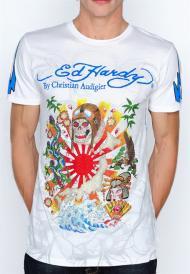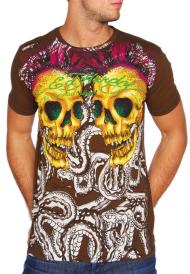Who’s Ed Hardy and why is everyone wearing him?

Zac Efron wears an Ed Hardy T-shirt in “17 Again” and I saw several
guys in bands at SXSW also wearing the $65 shirts emblazoned with the
big Ed Hardy signature over some vintage tattoo design. Even Madonna
and Elizabeth Taylor have been photographed in Hardywear.
It’s ironic that Hardy’s art (and designer Christian Audigier’s
marketing savvy) has become such a hit in the clothing trade. First
off, Hardy has long been an “art first” hard-liner who scoffed at the
creeping commercialism of tattooing. Then there was the day, 25 years
ago, Hardy sent a couple T-shirt designs to Mr. Lucky T-Shirts, where I
worked, at 2712B Guadalupe St. We sent ’em right back, with a shake of
the head, Hardy was always a bit too cool for the room. I only remember
one of the designs. It was a ferocious shark/German shepherd mix
snarling under the words “Jesus Eater.” Now who would wear that?
I’ve known Don Ed Hardy, who’s generally regarded as the greatest
living tattoo artist, since I was 19 years old, but that’s not to say
we’re good friends. I was tight with people in the tattoo world that
Hardy respected and so I was just the kid that was always around.
But being friends with Kate Hellenbrand, my first editor, and her
then-boyfriend Michael Malone, meant that I heard a lot about Hardy
through the years. He was the guy who took his lead from Sailor Jerry
and popularized Japanese-styled backpieces and sleeves in the U.S.
Before Sailor Jerry died in 1973 he instructed his family to sell
his shop at 1033 Smith St. in Honolulu to one of only three people: Ed
Hardy, Zeke Owens or Michael Malone. Jerry couldn’t stand the idea of
some hack working in his tiny shop, and those three were the rising
stars of the trade.
Hardy ended up going to Japan to study under the masters such as
Horiyoshi. Owens kept his shop in San Diego. And Malone bought Sailor
Jerry’s business, which came with hundreds of sheets of Jerry’s
original flash (tattoo designs) that now sell for about $3,000 each.

Hardy and Malone, who passed away last year, were great friends and
mutual admirers, but they’d have fallings out every few years, which is
not rare in the tattoo business. Hardy was more naturally gifted, a
true artiste, while Malone worked street level and told better stories.
The two had their own language, built around countless hours waiting in
“the scab hut” for military payday. If one called the other when
business was nonexistent and asked what was up, the answer would be
“just talking to the panthers,” in reference to the black designs on
the walls. A customer who passed out during a tattoo was a “mighty
hawk.” This comes from the time Malone tattooed a rather boastful
customer who wanted “‘The Mighty Hawk” on his arm. About halfway
through the M, the guy got clammy and took a flop. Malone stood over
him and said “‘Mighty Hawk, get up Mighty Hawk. Are you OK Mighty
Hawk?” Old-line tattooists have hundreds of stories like that.
Although Hardy was the first tattooist to charge $100 an hour for
his work, he was always more into furthering the art than banking big
bucks. Without any mathematical chance of making money, Hardy and his
partners rented the entire Queen Mary 2, anchored in Long Beach,
Calif., for the Tattoo Expo ’82. All the greatest tattoo artists in the
world were there, many meeting for the first time.
Hardy and his wife, Fran, also happily broke even in the ’80s,
publishing Tattootimes, an absolutely gorgeous magazine that featured
some of the best work being done at the time. Thanks to Hardy’s
efforts, tattooing started to be thought of as a higher art. But the
old rules still applied.
It used to be the only way to become a tattoo artist was to
apprentice for a working tattooist, who would pass on the tricks of the
trade in exchange for having a student/flunky for about a year.
Like all the other established tattoo artists of the time, Hardy
hated any shortcuts from that path. He was disturbed by the easier
access to tattooing supplies and guidance.
Usually you strive to be in on the ground floor of a business that
explodes in popularity, as tattoos have in the past decade. But many of
the old guys, who considered tattooing a secret society, were like the
Mafia veterans who refused to get into the heroin business back in the
’50s. There was a code of honor among the pirates.
Ed Hardy has retired from tattooing, one of the few art forms you
can’t do alone (unless you tattoo yourself, which is not recommended),
though he still owns his shop in San Francisco. And he gets those hefty
royalty checks from Christian Aubigier, who licensed Ed Hardy’s artwork
in 2004 after he left the Von Dutch brand. There are currently 27 Ed
Hardy clothing stores all over the world. Business Week recently
estimated that Hardy’s haul is “likely in the millions of dollars.”
Good for him.
Still, it’s kind of hilarious to see Paris Hilton or Ashton Kutcher
slipping past the velvet rope wearing a design Hardy tattooed on a
drunken sailor 35 years ago.
But his clothing line is a fad that will eventually go the way of
trucker hats.What will be next? Don’t be surprised if you one day see
Britney Spears stepping out of a limo wearing a T-shirt that says
“Jesus Eater.” Twenty-five years later, the world could be ready.
source: 1

Leave a Reply